Ten most distinctive features of ARPHA
(1) End-to-end software platform + human-provided services
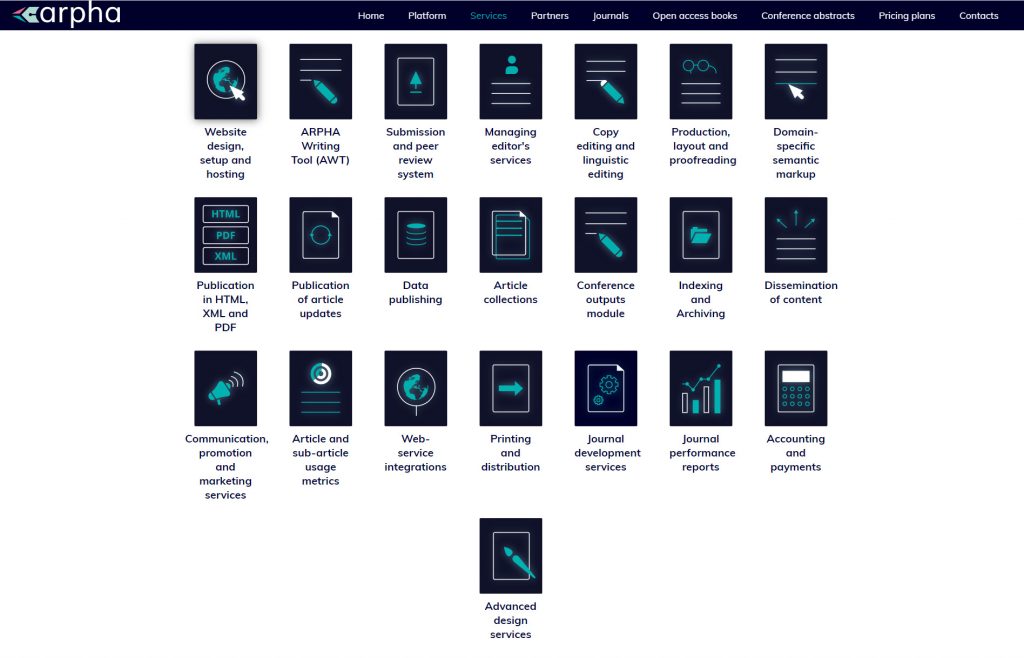
ARPHA is a full-featured publishing platform providing: an authoring tool, peer review, production, publishing, hosting, indexing, archiving and dissemination of content.
This means that journals or publishers moving to ARPHA will avoid the burden of dealing with various software or service vendors (e.g. one for submission and peer review, another for production and a third for publishing and hosting).
The benefits from this seamlessly integrated workflow is that all team members (editors, reviewers, authors, layout managers and linguistic editors) can work within a single environment, where they can benefit from:
- one-stop entry and unified interface from the start to the end of the publishing process;
- reduced manuscript turnaround times;
- in-built tools for monitoring and control at all stages of the publishing process;
- data security and GDPR compliance;
- reduced costs and optimised cost/quality ratio.
Complementary to the integrated and user-friendly software platform, ARPHA offers a full range of services provided by our team or external vendors. This gives journal editors the flexibility and freedom to outsource some processes to ARPHA’s team or continue using its own staff or vendors.Additionally, we offer advanced journal performance reporting services designed to assist the Editors-in-Chief and managing editors in keeping an eye on the journal’s development and management.
(2) White-label and (co-)publishing
ARPHA can be used as a white-label solution, meaning the platform will operate under a journal/publisher’s own logo and imprint.
In other cases, especially for starting journals, a (co-)publishing solution together with ARPHA’s developer Pensoft Publishers may bring additional benefits in terms of recognition, promotion, development and goodwill.
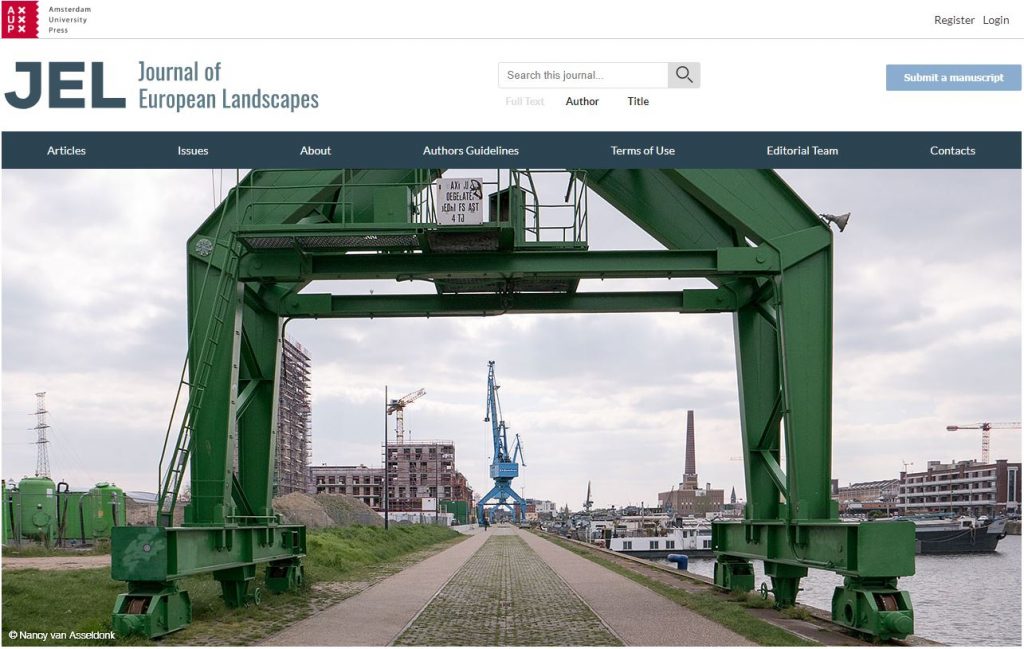
Visit at: https://journalofeuropeanlandscapes.eu/ .
Use case I: Being an internationally recognised publisher, the Amsterdam University Press (AUP) opted for the white-label solution of ARPHA. To date, the publisher has moved three of its journals to the new platform (Maandblad voor Accountancy en Bedrijfseconomie, Journal of European Landscapes and Heritage, Memory and Conflict Journal), all of them benefiting from an individual design that fully honours their identity as part of the AUP’s journal portfolio, while at the same time, featuring the modern look and feel that comes with ARPHA.
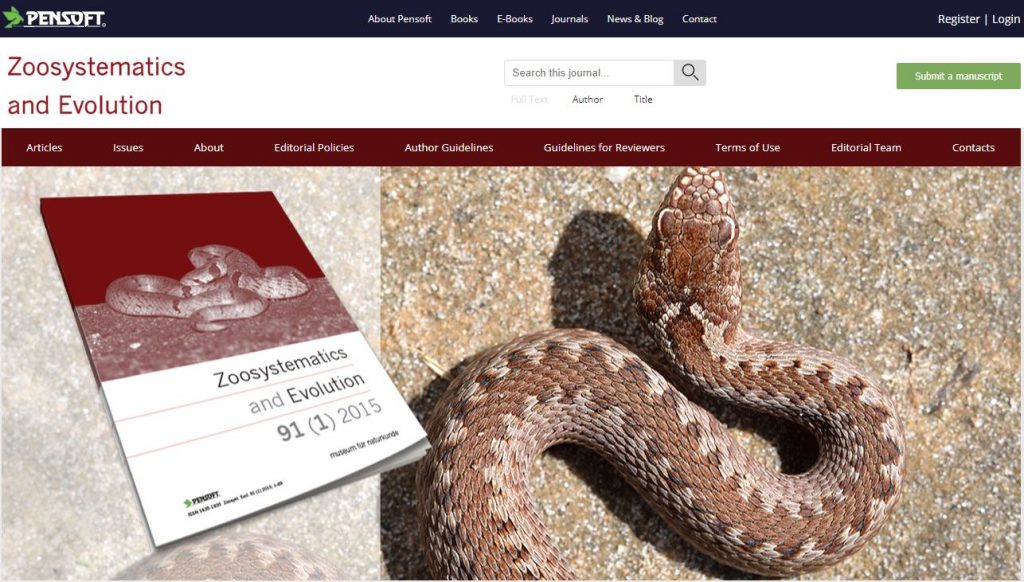
Visit at: https://zse.pensoft.net/ .
Use case II: Alternatively, the Museum für Naturkunde (Natural History Museum), Berlin, took a decision to flip to open access and modernise their historical journals Deutsche Entomologische Zeitschrift (since 1859) and (since 1890, journal name changed) on ARPHA under the strong publishing brand of the platform’s mother company, Pensoft Publishers.
(3) Operational flexibility
The software modules or human-provided services can be selected on choice, so that they align with the journal’s existing workflows, future needs and budgetary requirements.
Use case I: Where journals already maintain their own editorial and/or production staff, they can opt to use ARPHA’s software platform in part and keep some of the work (e.g. editorial management and production) in-house. For example, the Plant Sociology journal of the Italian Society for Vegetation Science (SISV) decided to go for ARPHA’s ADVANCED pricing model, while continuing to use their own copy editing and typesetting services, leaving to ARPHA the building and maintenance of the entire editorial management and publishing platform, along with the highly specialised work on XML tagging and semantically-enhanced publishing. As a result, the journal achieved a quick technological modernisation, while significantly optimising its operational costs, allowing authors to publish with APC as low as €350 (€250 for society members).
Use case II: When the European Science Editing (ESE) journal, published by the European Association for Science Editing (EASE), enquired about ARPHA for possible use of its software and services, we decided to provide the platform for free, given the importance of the Society’s activities for increasing the quality and integrity of science publishing in Europe. During the negotiation phase, it appeared that the Society found its own way to typeset the articles to PDF, while the XML services had to be provided by ARPHA. At the very end, ARPHA and EASE decided to publish the journal as PDF only and move to HTML/XML later on, possibly after the second or third year. The result of this was an entirely free publishing in the ESE journal, while the transition to HTML/XML can happen at any point selected by the Society.
(4) Affordable and flexible pricing models
ARPHA publicly offers a transparent cost structure for its services. Each pricing plan contains a detailed account of the software modules and human-provided services. A journal can select from four pricing models that, depending on the publication volume, may amount to the following exemplary yearly costs:
EXAMPLES OF APPROXIMATE YEARLY COSTS (€)
| Exemplar journal | LITE | BASIC | ADVANCED | PREMIUM | |
| 2 issues 20 articles / year | €1,600 | €3,500 | €7,500 | €11,500 | |
| 4 issues 40 articles / year | €2,200 | €5,500 | €13,500 | €21,500 |
Use case I: Check List is a large international journal operating mostly in the Global South, which sought an inexpensive publishing venue for its authors, while providing them with a modernised and technologically-advanced platform. ARPHA elaborated a custom business model for Check List based on PDF-only publishing, but providing distribution of metadata in XML and HTML, thus allowing the Article Processing Charges (APCs) for authors to be reduced to €120-€150.
Use case II: The journal Evolutionary Systematics of the University of Hamburg is published on ARPHA under the conditions of a fixed yearly budget which does not need to be calculated on the basis of the number of articles published per year. ARPHA customised a business model, based on a fixed number of pages published each year, which allowed for flexibility in publication of articles of different size within the yearly limit, while keeping the costs in accordance with the planned budget.
Use case III: The journal Alpine Entomology inherited the historical journal Mitteilungen der Schweizerischen Entomologischen Gesellschaft, which has been published by the Swiss Entomological Society since the middle of the 19th Century in black-and-white printed format only. In an open discussion with the journal’s editorial board, ARPHA was able to offer a model that allowed the building of a new website, publishing of the journal at the highest possible technological standards in semantic XML, HTML and PDF, printing 300 full-colour copies for distribution to society members and still allowed the saving of a small part of the journal pre-ARPHA budget!
(5) Various business models
A journal can operate on ARPHA using a wide variety of business models, for example:
- Diamond open access – all costs are covered by an institution, society or third parties and the authors publish for free. The benefit of using ARPHA is that the costs of maintaining diamond open access for the journal owner will be FAIR, LOW and TRANSPARENT.
- Mixed model – part of the costs can be covered by an institution, society or third parties and part from author’s APCs. The benefit of using ARPHA is that, with this model, the APCs for the authors can be kept as low as to be considered symbolic, in comparison even to average market standards.
- APC-based income model – a society or institution may set APC that cover the production costs or add a surplus on the top of ARPHA’s prices. The benefit would be financial sustainability through generation and sharing of income.
- Differentiated groups model – some authors can publish for free (e.g. staff or society members), others can benefit from discounts or waivers (e.g. from low-income countries) and a third group of authors can pay full APCs. The benefit of using ARPHA is that its accounting and online payment modules can be tuned to cater for administration of fees for different user groups.
- Custom-fit models that can be elaborated together by the journal and ARPHA.
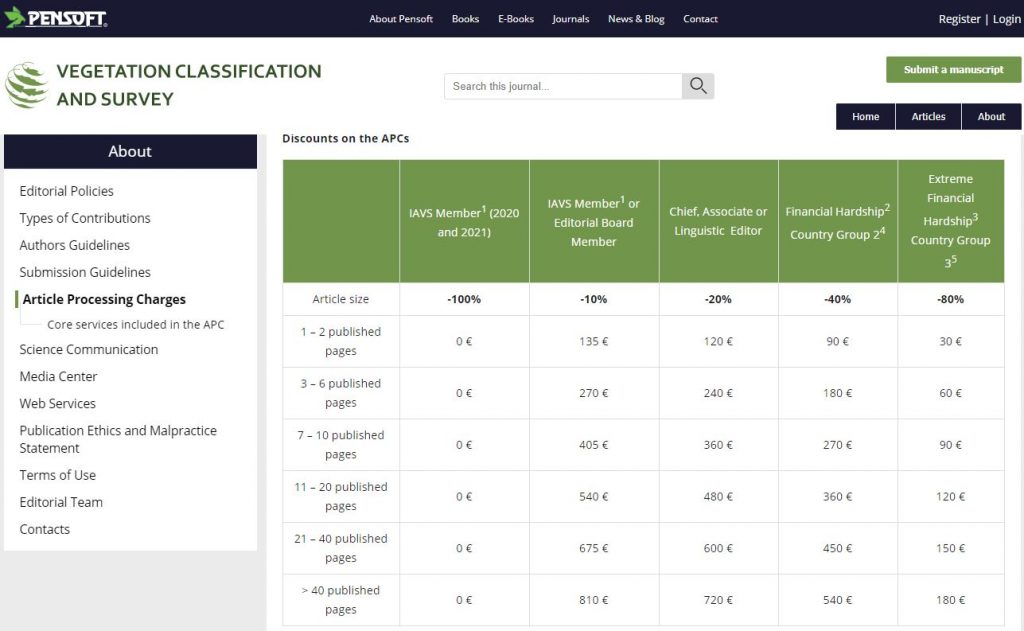
Visit at: https://vcs.pensoft.net/about#ArticleProcessingCharges.
Use case: The International Association for Vegetation Science (IASV) decided to add a new journal Vegetation Classification and Survey to their portfolio, aiming at not-for-profit financial sustainability of the journal achieved over a period of three years. ARPHA supported a quite complex and highly-automated APCs model, ranging from free publication during the first year, low APCs during the second and below market average APCs during the third year and beyond, with different levels of discounts and waivers for society members, journal editors and authors from different groups of low-income countries, based on the World Bank classification. As a result, the journal is expected to become cost-neutral for the Society or even to bring in a small income for it, while offering APCs that are two to three times lower than those charged by large commercial publishers.
(6) Language flexibility
The majority of journals on ARPHA are published exclusively in English. Still, some journals prefer to operate in other languages, depending on their audience of authors and readers. ARPHA supports bilingual solutions at interface, metadata and content levels.
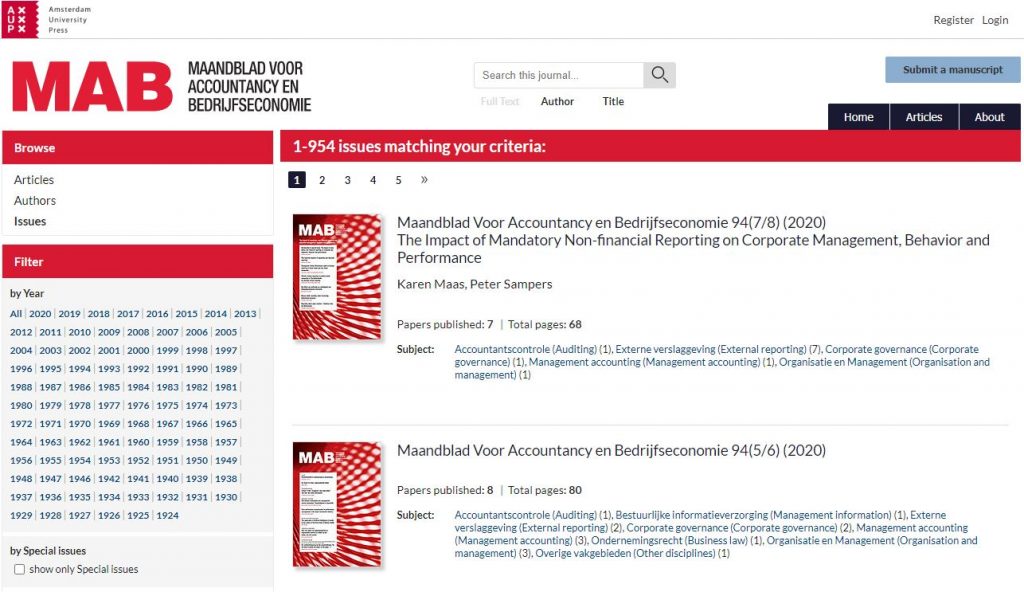
Additionally, on the journal’s website (visit at: https://mab-online.nl/), you can also find MAB’s historical content, which dates back to 1924.
Use case I: The journal Maandblad voor Accountancy en Bedrijfseconomie of the Amsterdam University Press transitioned to open access and XML publishing on ARPHA in 2017. The journal wanted to keep the metadata and website interface exclusively in English, so that it is generally understandable to the international audience, but at the same time, the main content and journal’s news announcements to be published exclusively in Dutch. The result was more than satisfactory for the editors, authors and readers, especially after ARPHA uploaded the journal’s historical content (since 1924) and made it searchable and discoverable at article level on MAB’s new website.
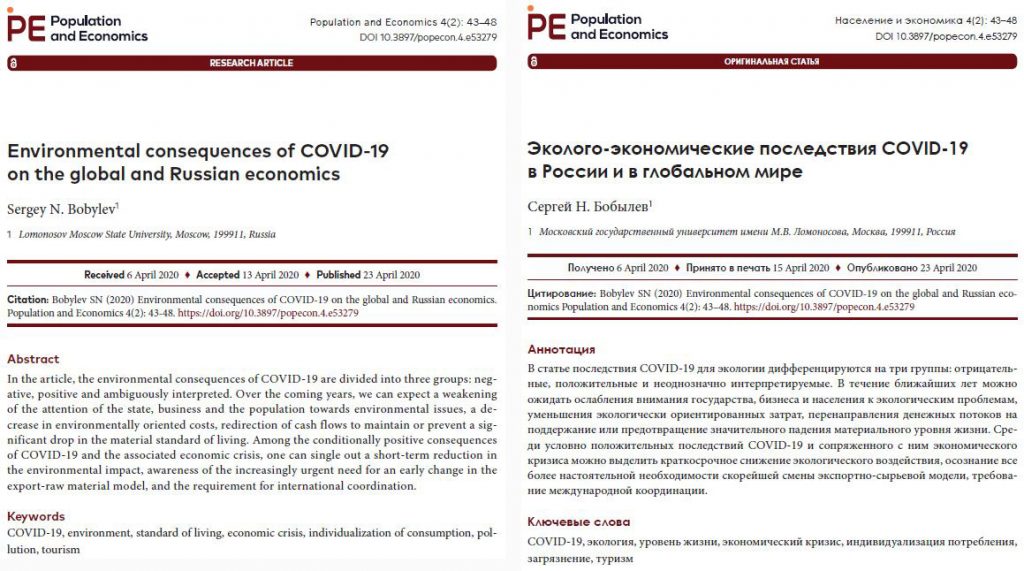
To avoid potential confusion in references, citations etc., both the Russian- and the English-language articles are using the same DOI.
Use case II: The journal Population and Economics, published by the Moscow State University, was established as an international journal publishing exclusively in English, while also offering its content in Russian to the vast community of Russian economists and population geographers. ARPHA created a special solution for formatting and publication of a Russian version of all articles, identical to the primary English text and formatted according to the journal’s design standards. The Russian version is published as PDF under the same DOI as the English version and under English Language metadata only; a special statement is included in the Russian version to be cited with its original English metadata to avoid splitting the citation counts between the two language communities.
(7) Multi-purpose platform
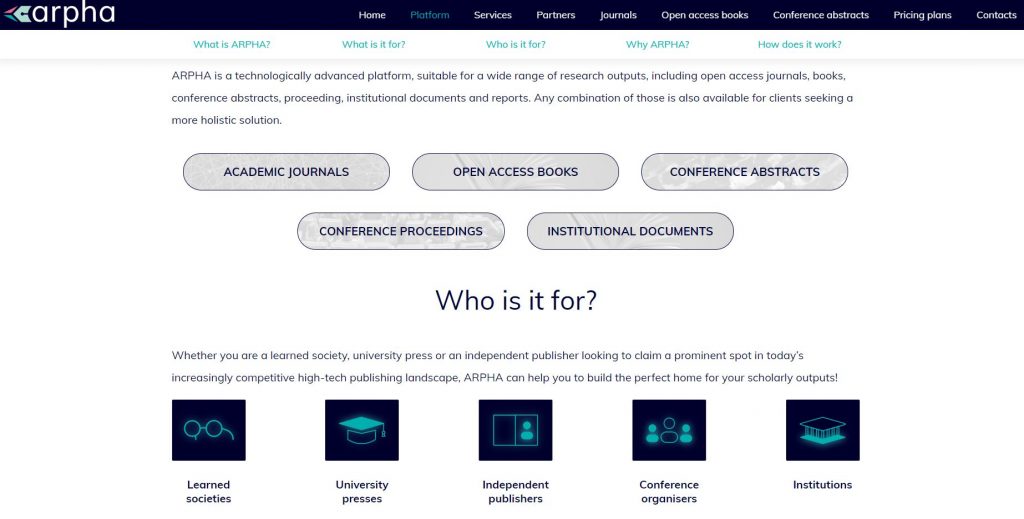
ARPHA can be used for publication of journals, books, conference abstracts or full-text papers, preprints and institutional documents.
For all these different products, ARPHA can create multifunctional platforms for institutions and societies operating under the customer’s logo and branding.
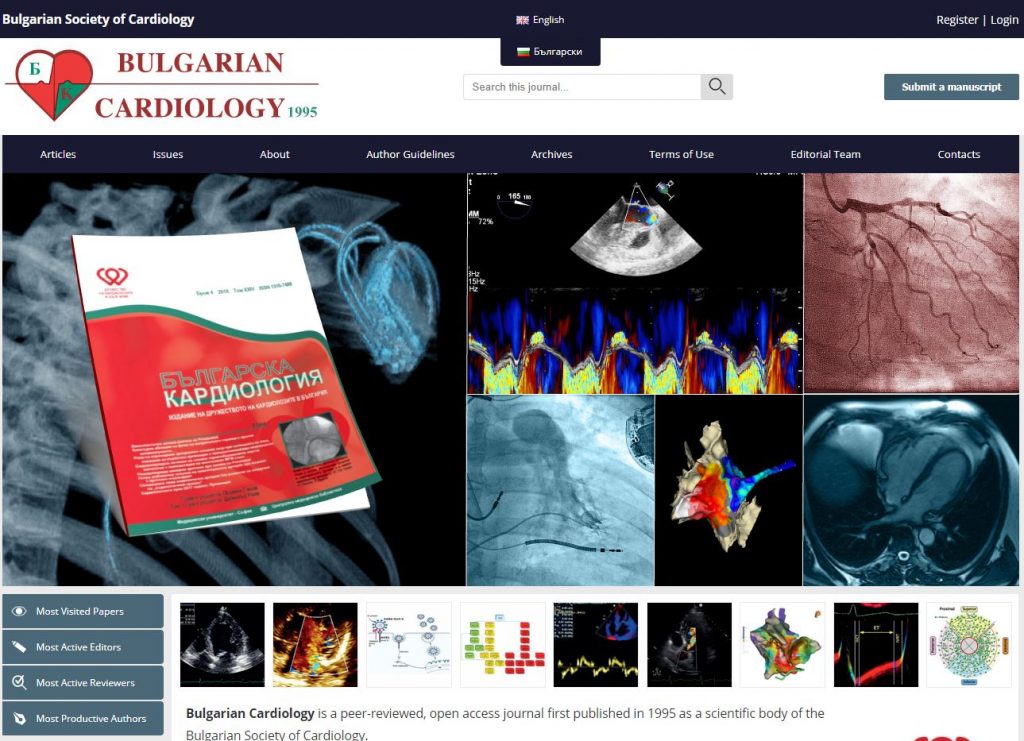
Visit at: https://journal.bgcardio.org/?lang=en.
Use case: The Bulgarian Society of Cardiology transferred its 25-years old journal Bulgarian Cardiology on ARPHA in 2019. The journal is multilingual and publishes articles in English, Bulgarian and occasionally in other European languages. The new ARPHA-designed website of Bulgarian Cardiology provides a bilingual interface and the possibility to publish both English and Bulgarian language metadata and articles in either of the two languages. Shortly after the journal’s launch, the Society commissioned a new society website following the journal’s corporate design, yet providing a wide variety of other features to present the Society’s activities, publication of various documents, news items and so on. Both websites are available through a platform built on the Society’s domain address bgcardio.org.
(8) Technological innovation and relevance
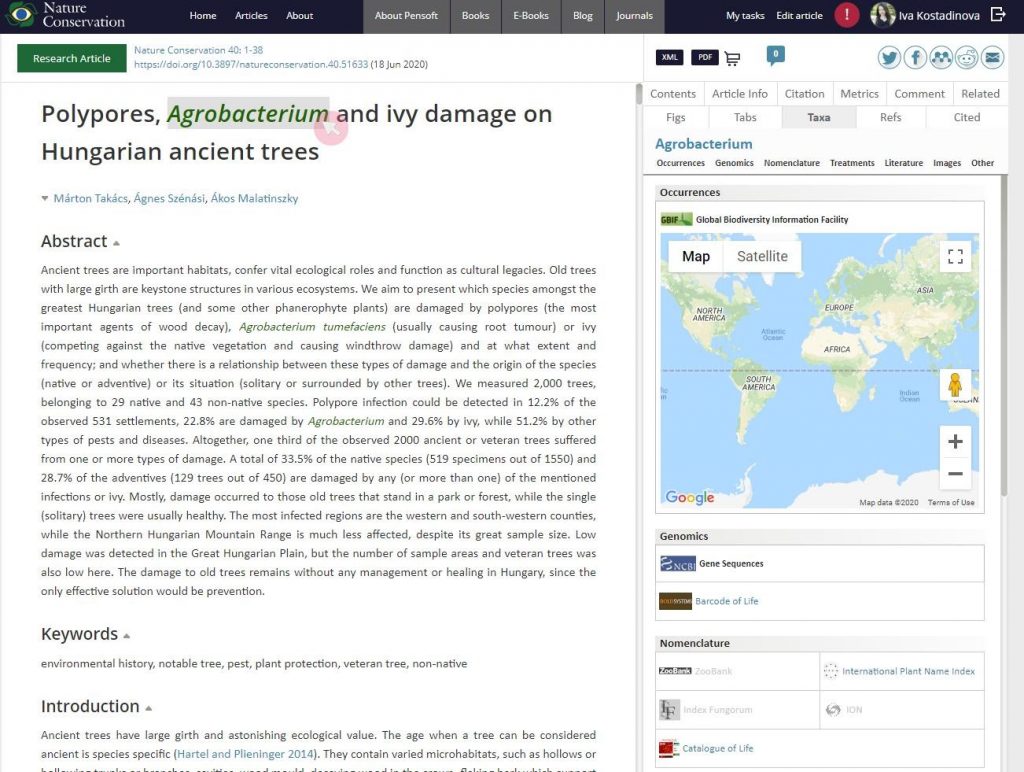
ARPHA provides the highest technological publishing and dissemination standards, including several innovations, for example:
- Amongst the most prominent technological innovations of the platform is the advanced semantics publishing module, which allows tagging and enhancement of content and the development of multiple interactive tools linked to the article’s content. This module is now fully operational for the domain of Biology, but can be developed for any field on demand of the client.
- Another useful feature of the platform is the fully-automated indexing and archiving module. All content is instantaneously distributed on the day of its publication via web services, saving valuable time and effort in the editorial office.
Use case I: One of the most remarkable and well-known innovations of ARPHA was the 2013 launch of the first ever entirely XML-based and fully-integrated authoring, peer review and publishing workflow, exemplified by the highly successful Biodiversity Data Journal (BDJ). The ARPHA-XML workflow offered a number of globally-unique features, most of which are still unrivalled by other platforms, for example, import of data from data aggregators directly into the manuscripts via web services or the automated conversion and submission of metadata from data repositories into data paper manuscripts.
Use case II: In 2015, the ARPHA-XML workflow was used to establish the Research Ideas and Outcomes (RIO Journal) as the first open science journal aiming at publication of all outputs from the research cycle: from research ideas and grant proposals to methods, data, software, project reports, research articles and many more. The unique features of RIO resulted in the winning of the SPARC Innovator AWARD for 2016.
(9) High-level integration via web services & data exchange
ARPHA is fully integrated with more than 60 industry leading indexing and archiving services. Our partners include CrossRef, DOAJ, Clarivate Analytics, Scopus, Zenodo, OpenAIRE and PubMed Central, to name just a few.
The full automation of processes within ARPHA means that all content is directly exported upon publication without any extra human effort. This means that publishers and Editors-in-Chief can sit back and relax after pressing the “publish-an-article button”, while ARPHA makes sure that all their content is safely archived and successfully disseminated.
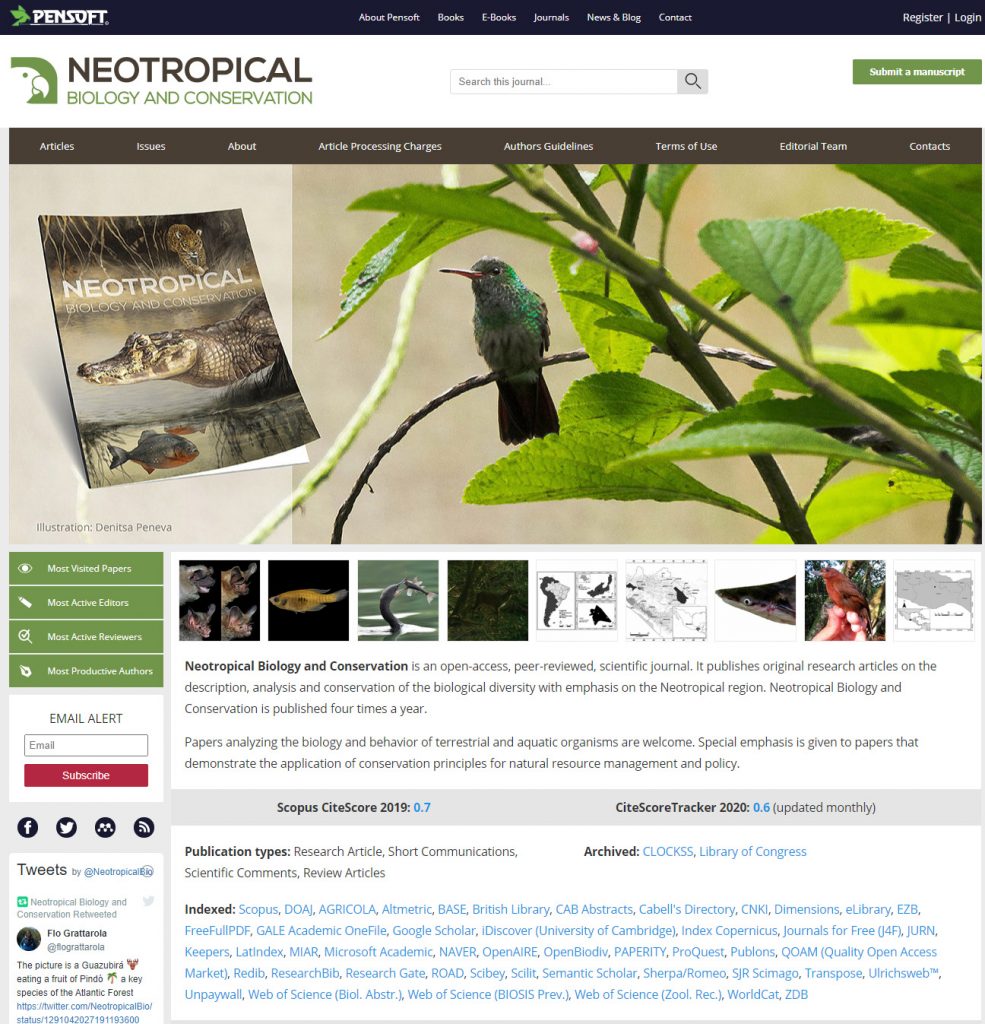
Visit at: https://neotropical.pensoft.net/.
Use case: The journal Neotropical Biology and Conservation (NBC) was established and published by the University of Rio dos Sinos (UNISINOS), Brazil, by a team of motivated scientists. The journal was quite well-known and was indexed in Scopus and several other resources. At some point the editors realised that modern journal publishing requires much more than good scientific expertise and motivation, due to the rapidly evolving and highly competing science publishing market. In 2019, NBC was transferred to Pensoft and hosted on ARPHA. Particularly useful in the whole process proved to be the automated indexing and archiving functionality that is in-built with each plan of ARPHA. Previously submitted “by hand” by the Editor-in-Chief following each indexer’s specific requirements, this task used to be burdensome for the editorial office and results were prone to errors. After the move, all metadata was not only submitted automatically to all services previously used by the journal, but NBC could take advantage of disseminating their content to a package of more than 50 indexers and archivers (listed on the journal’s homepage) that automatically comes with the platform.
(10) Personal approach in technical support and consultancy
Journals joining ARPHA will enjoy a personal, reply-within-a-business-day, approach from a designated team member and benefit from operational training and technical support included in all pricing plans.
The platform also offers consultancy and support in journal development, indexing and archiving and marketing and promotion. All these services are elaborated in fully transparent and flexible plans, so that editorial boards can opt for services they really need, in order to improve the journal’s performance.
Use case I: ARPHA is built on the principle of transparency and openness and the platform even offers options for open peer review and annotations. However, when the newly-established journal Rethinking Ecology expressed a strong case for the need of a double-blind peer review functionality for the specifics of their work, the feature was developed and introduced on the platform and it is now available as an option for all users on ARPHA.
Use case II: When the journals Russian Journal of Economics and Population and Economics moved to ARPHA, the editorial boards wanted to make the most of the new platform and its features, with the shortest possible uptake time for their in-house staff. As a result, a two-day training was organised for the editorial teams in their Moscow offices, where they received an induction to the platform’s technical features, insights on how to make the most of its workflows and complementary training in journals’ promotion and PR. This induction has led to the requirements of the Editorial Board for these journals being met and successful adoption of the ARPHA platform.

